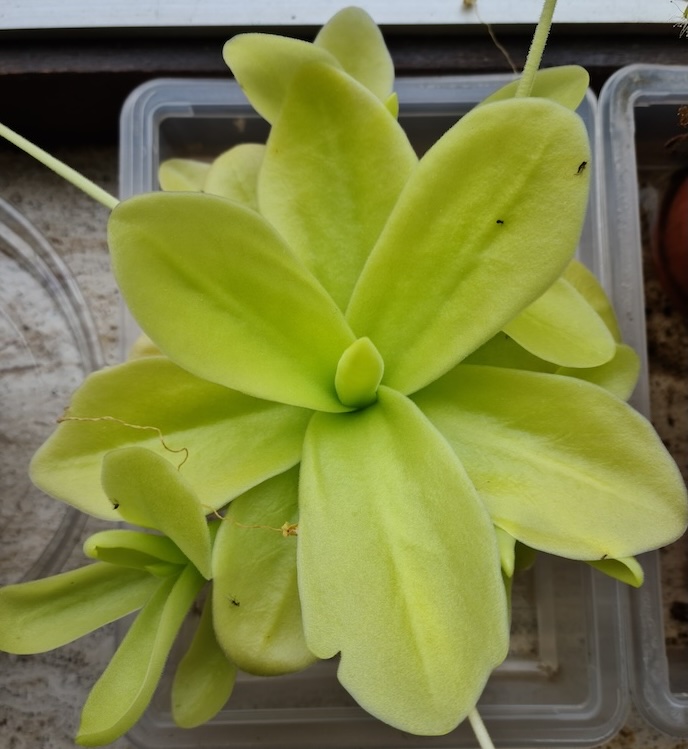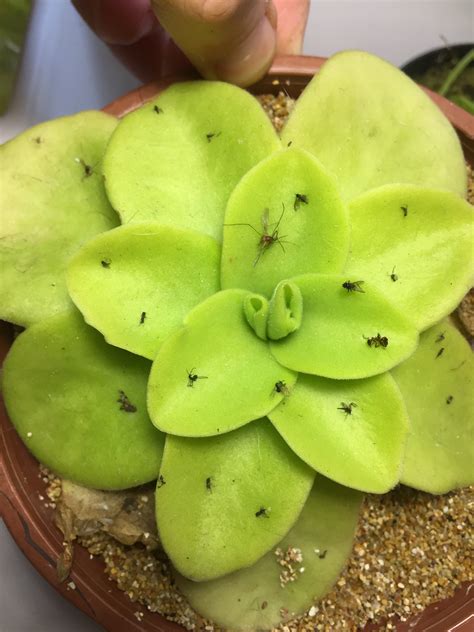

Pinguicula gigantea
General
Pinguicula gigantea is a captivating carnivorous plant species native to the cloud forests of central Mexico. Recognized as the largest butterwort, it is renowned for its decorative wide leaves covered in a glistening layer of sticky mucilage. As both a beautiful and effective insect-trapper, it is adored by enthusiasts both for its horticultural value and its easy-going nature compared to many carnivores.
Physical Characteristics
This butterwort grows as a rosette, with succulent leaves that can reach up to 30 cm (12 inches) across in mature specimens. Each leaf is flat, vivid green, and lightly curled at the tips. The upper leaf surface is densely covered with glandular hairs producing sticky droplets, which are vital for trapping prey. Flower stalks can rise above the rosette, producing attractive, violet-lavender flowers with a delicate, lobed structure, often appearing in flushes throughout the year.
Lifestyle
As a carnivorous plant, its main strategy involves luring, trapping, and digesting tiny insects — especially gnats, fruit flies, and springtails. The sticky mucilage on its leaves acts as both glue and digestive medium. Insects become ensnared and are gradually broken down by enzymes, with the nutrients absorbed through the leaf surface. This nutrient-boosting adaptation helps the plant thrive in nutrient-poor substrates.
Habitat and Protection
In its natural setting, it grows on limestone cliffs and moist rocky outcroppings, often exposed to frequent mist and is shaded by taller vegetation. The environment is humid, with moderate temperatures and good air circulation. In cultivation, it's important to simulate these conditions, avoiding high-nitrogen soils and protecting the plant from frost. While not immediately threatened, habitat loss remains a concern, highlighting the need for responsible collection practices.
Cultivation
It’s popular among carnivorous plant growers for its robust constitution and tolerance of indoor conditions. Beginners are often successful with the species due to its forgiving nature, provided that the basics of light, water, and soil are met. Its simple care requirements and relatively fast growth make it a rewarding project even for those new to carnivorous plants.
Special Features
The leaves possess extraordinary mucilage glands not just for capturing prey but also for repelling water, helping protect against excess moisture and fungal infections. The flowers are not only beautiful but also attract pollinators without putting prey at risk, as they’re borne well above the sticky leaves. The plant’s unique ability to propagate through leaf cuttings further fascinates growers.
Care
Light
Bright, indirect sunlight is preferred — an east or west-facing windowsill is ideal. Some morning or late afternoon direct sun is tolerated, but harsh midday rays should be diffused to avoid leaf burn.
Temperature
It thrives between 18°C and 28°C (64°F to 82°F). Short dips to 10°C (50°F) are tolerated, but extended cold can stress or kill the plant. Avoid heat spikes above 32°C (90°F).
Water
Water with rainwater, distilled, or reverse osmosis water. Keep the soil consistently moist but not waterlogged by standing the pot in a shallow tray of water. Reduce watering in winter if temperatures are cooler.
Soil
Use an airy, well-draining mix — a standard recipe is 1:1 perlite to peat moss, or a blend of perlite and vermiculite with a bit of orchid bark. Avoid any added fertilizer or minerals.
Nutrition
Prey capture is typically sufficient for nutrient needs. Do not fertilize routinely; if supplementing, a very dilute orchid foliar spray can be used sparingly during periods of active growth, but it is not necessary.
Humidity
High humidity (50–80%) is ideal, though established plants adapt well to lower humidity if watered carefully and protected from drafts. Good air circulation reduces mold risk.
Dormancy
Unlike many butterworts, this species does not have a true dormancy but may grow more slowly in winter. Just slightly reduce watering and keep temperatures moderate. No special rest period required.
Common Problems
Leaves discolor or burn
Cause: Too much direct sunlight without gradual acclimatization.
Solution: Allow the plant to gradually get used to brighter light by slowly increasing its exposure to direct sunlight.
Brown leaf edges
Cause: Hard tap water or excessive fertilizer concentration.
Solution: Use only soft (rain/demineralized) water and do not use chemical fertilizer.
Limp or wilting leaves
Cause: Overwatering or poor drainage leading to root rot.
Solution: Repot using a well-draining mix and ensure pots are never standing in deep water.
White, fuzzy patches on leaves
Cause: Fungal infection due to excessive humidity and stagnant air.
Solution: Increase air movement and remove affected leaves; consider a gentle fungicide if needed.
Failure to flower
Cause: Insufficient light or nutrients.
Solution: Provide more bright, indirect light and allow the plant to catch prey or use a highly diluted foliar fertilizer during the growing season.
